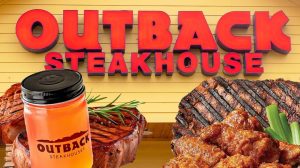When Charles Goodnight invented the chuck wagon – perhaps the first mobile kitchen — in 1866, he likely had no idea his brainchild would evolve into the food trucks of today. Chuck wagons were used to feed cowboys on the cattle trails of the Old West. Since then, the idea of selling food from a moveable kitchen has included everything from food carts selling hot dogs on street corners to ice cream trucks meandering through suburban neighborhoods.
Today, the global food truck market is expected to reach $5.78 billion by 2028. These trucks have become a vital part of the food scene in cities and rural areas alike. They’re bringing diverse, restaurant-quality food to neighborhoods, festivals, and city streets. As the industry grows, so do the crowds of people who turn to food trucks when they are out and about and hungry.
Whether you’re a food truck regular or it’s your first time at the window, there are simple steps you can take to make your experience a smooth one. Minding your manners is at the top of that list. No elbows on the table, and napkins in your lap are the dining etiquette rules most of us know not to break, but food trucks have their own unique set of practices.
We interviewed Kirk Francis — owner of a fleet of Washington, DC-based food trucks called Captain Cookie & The Milkman — about food truck best practices. Follow these etiquette rules for the best experience on your next food truck visit.
Be ready to order
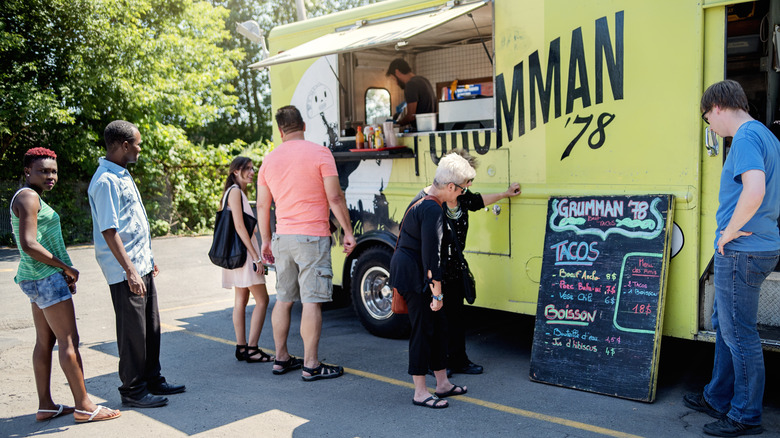
There’s nothing worse than waiting in a long line to order food and having the person in front of you spend several minutes finally reading the menu or asking, “What do you have?” This is even more frustrating at a food truck, where you may have been standing in line in the heat or rain for up to an hour on a busy day. When you reach the food truck window, be courteous to those in line behind you and be ready to order.
On a slow day, Francis doesn’t mind if customers take their time at the window, but he encourages customers to be prepared. “If there’s a huge line, please be respectful of everyone’s time by having your order ready,” he advises. “If you have young kids, please try to coach them in advance so they’re ready to order, too.”
Food trucks make it easy for you to make your selections before you reach the window. Most have their menu either on the side of the truck or mounted on a board near the truck so you have plenty of time to check it out while you wait. Many mobile restaurant menus now include QR codes, making it easy to browse the menu ahead of time.
Be patient
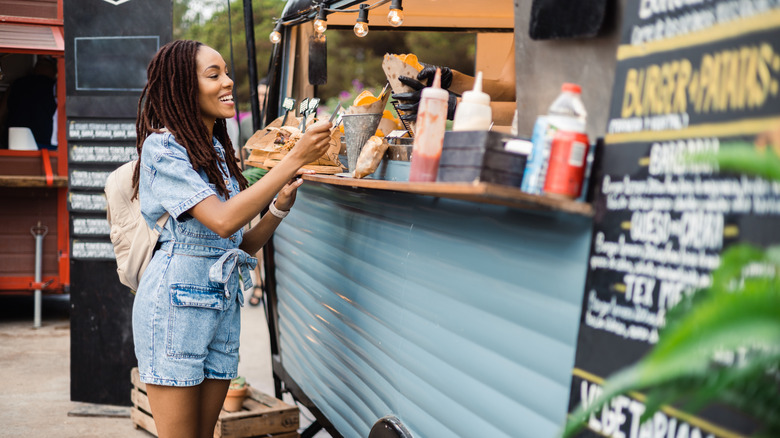
Server, host, line cook, food runner, chef, general manager — these are just a few of the positions it takes to run a restaurant successfully. Each staff member has a unique set of responsibilities and when everyone works together, service runs smoothly. Most food trucks are typically staffed with a handful of employees. In fact, it’s not uncommon to find a truck with only one or two employees aboard. They’re still operating a working kitchen with a limited menu, taking and filling orders, but with a much smaller team in a setting that’s often cramped and loud, so don’t let your hunger pangs get the best of you. Bring your patience with you when you’re visiting your favorite food trucks.
“Food trucks can be noisy,” says Francis. “So sometimes it’s hard to hear the order over the generator, oven, fryer, etc.” Speak up when ordering and give the staff some grace if they ask you to repeat yourself.
Once you’ve placed your order, you can expect to wait anywhere from five minutes to more than an hour depending on how large the crowd is and what you’ve ordered. Never board the truck, especially not to complain about your wait time. Remember that the cooks are working hard in a tight space to get your food to you quickly, so be patient with them.
Respect the line
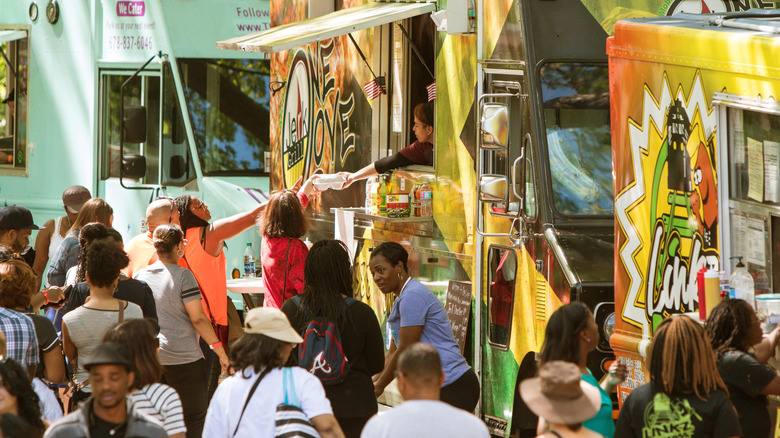
BluIz60/Shutterstock
Most of us have been lining up for one thing or another since pre-school. Whether we’re lining up to walk to gym class or waiting in line at the bank, rule number one of all lines is no cutting. This should be common knowledge, but it’s surprisingly common for people to cut a long line, especially when the weather’s less than ideal.
At no point is it acceptable to butt ahead of people who were in line before you. Doing this in a line of hungry folks waiting for food is likely to lead to harsh words or even worse trouble. You should also avoid holding space in line for your posse of friends who haven’t yet arrived.
Saving space might seem like a helpful thing to do for your friends, and the consensus is it’s fine if it’s one person. But it’s not courteous to the food truck lovers in line behind you to have several people arrive and jump ahead of them in line. Francis thinks it’s fine to hold a place (within reason), so long as you “alert the folks behind you in line that you have others joining you.”
Keep it moving
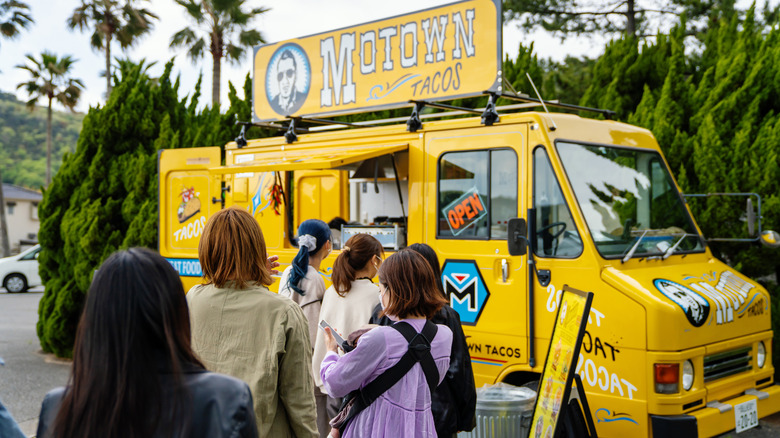
Tdub303/Getty Images
Crowds are a common occurrence when food trucks are involved. Making sure those crowds are kept in motion is a key part of a food truck team’s job; people waiting to order combined with people waiting for their food can create the worst kind of traffic jam.
In addition to prep work, cooking, and dealing with customers, managing the flow of traffic outside the truck also falls on the shoulders of the staff working inside the truck. You can make their job easier by keeping it moving. Resist the temptation to stay in front of the window to watch the action inside the truck once you’ve ordered. Staying put can create a bottleneck.
Posting up in front of the food truck window after you’ve placed your order makes it impossible for customers behind you to access the window to place their own orders. It also blocks the path for anyone trying to pick up their order when it’s called.
“Step aside. I promise we’re working as fast as we can,” recommends Francis. “Just stay within earshot.” It’s important to stay close to the truck so you can hear when your name or order number is called.
Share the seating

Mei Yi/Shutterstock
Food trucks are built for serving great food to customers while they’re out and about. If you live in an urban area, you might be used to visiting food trucks on busy city streets where customers line up on sidewalks and take their food to go. Trucks operating in more suburban neighborhoods (or cities where trucks are permitted to set up near public parks) give customers access to some seating where they can enjoy their meals.
When seating is available, it’s important to be courteous to those around you. You should feel free to grab a seat and enjoy your meal, but don’t dawdle. Once you’re done, move along. You’ll give other diners an opportunity to have a seat while they eat.
Francis says that the amount of time you spend seated near food trucks should depend on how crowded the area is. “If others are waiting to sit and eat, please move along,” he says. “If not, feel free to linger.”
Tip if you can

SR Productions/Shutterstock
Leaving a gratuity for exceptional service in a restaurant is commonplace. Some restaurants even add a 20% gratuity to bills for larger parties. The rules around tipping when you visit a food truck are not as clear. Should you leave a tip when ordering from a food truck? 40% of customers don’t, according to a recent survey by Forbes Advisor.
It’s easy to find the logic in tipping at a full-service restaurant where you are seated and served a meal. The tip boosts your server’s typically meager hourly pay rate, and rewards them for excellent service. Food trucks operate more like a counter service restaurant, where you pick up your food from the counter and take it with you. Tipping is not required at these establishments and it’s also not required at food trucks.
Requirements aside, if you are able to tip and want to reward a food truck staff’s excellent food or service, be generous and leave a tip. However, you might choose not to tip if you notice any of these food truck red flags.
Clean up after yourself
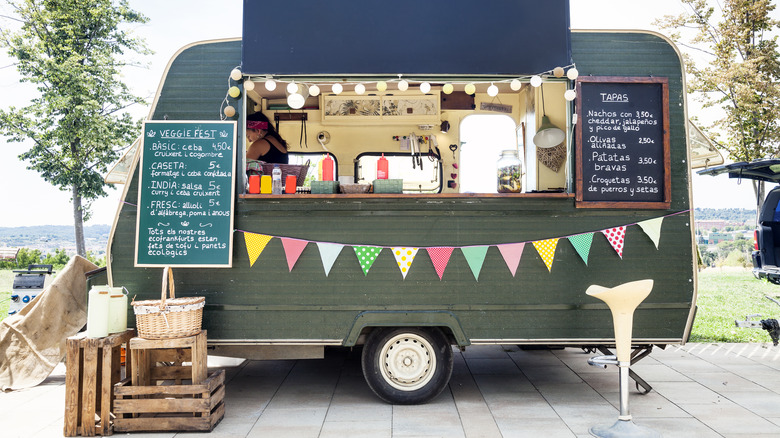
Maica/Getty Images
Wherever you stop to eat your food truck fare, always remember to clean up after yourself. Unlike at a restaurant, trucks don’t have staff dedicated to clearing tables or cleaning up after customers so it’s up to you to help keep the seating or dining area clean.
If you don’t see a trash can nearby, ask the truck staff where you can dispose of your garbage. The worst thing you can do in this scenario is leave your leftovers or other trash on the table or bench where you ate (or littered on the sidewalk). Food truck staff have enough headaches to deal with already, so do your part in making their jobs a little easier.
Depending on the location and how busy the truck is, “The food truck employees will likely come periodically to wipe down tables, but it’s rare for them to bus tables,” says Francis. “Customers should dispose of their own trash, generally speaking.”
Doing your part to keep the space around the food truck clean makes sure customers who come after you also have an enjoyable food truck experience.






